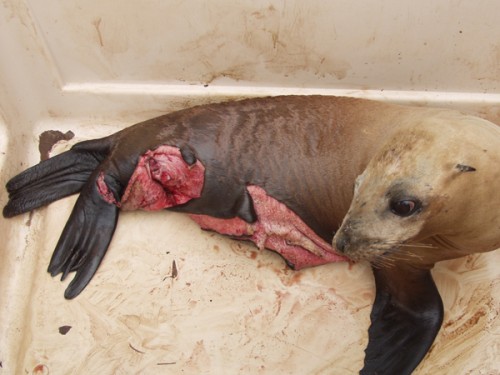
On this month's Oddities in the News Page: Shark chases little girl on Hawaiin beach but she escapes unharmed
Note: the photos are stills taken off a video, which is why that may appear a little blurry. To see the video, go HERE



May 5 (UPI) -- A mother recording her 6-year-old daughter playing in the waves at a Hawaii beach captured the moment the girl was chased out of the water by a shark.
Sheri Gouveia said she was recording video of her daughter, Anela Rezentes, at Kalama Beach in Kailua when the girl suddenly ran from the water and shouted that she had seen a shark.
"By the time she came out of the water, she was hysterical," Gouveia told KHON-TV. "I was like, 'oh my gosh.' So I ran up, but I was looking for it but couldn't see it. I didn't realize it was actually a shark. That's what shocked me."
Gouveia reviewed her video footage and discovered a shark had indeed come within inches of her daughter.
"I saw a shark. I didn't notice he was behind my back. So I really wanted to run out. I was really scared," the girl said.
Experts reviewed the video and said it appears to be a blacktip shark, a species known to hunt for fish in shallow waters.
Others were not so lucky
Before you view the photos at the bottom of this page, please remember:
Most people think of sharks as vicious predators. This state of mind was popularized by the movie Jaws, and more recently, by Deep Blue Sea. However, the perception is both unfortunate and incorrect, since there are relatively few unprovoked shark attacks on humans worldwide. Of the more than 350 species of shark in the world's oceans, only a handful of them are considered dangerous to humans.
Shark attacks happen infrequently, and only 79 attacks were reported world-wide in 2010. That is a very small number when you consider that there are almost seven billion people on the planet.
In reality, sharks are a critical part of marine ecosystems. They are a source for knowledge to help the human condition, and the basis of a valuable fishery. Great whites are relatively uncommon large predators that prefer the cooler waters of the deep ocean. In some parts of their range, great whites are close to being endangered.
The biggest enemy to sharks are man, and we need to preserve them.
However, when shark attacks do occur, they can be pretty shocking, as observed by the photos below.




The movie JAWS was based on a true story
The Shark Attacks That Were the Inspiration for Jaws
One rogue shark. Five victims. A mysterious threat. And the era of the killer great white was born


In the summer of 1916, panic struck the Jersey Shore. A shark sunk its teeth into Charles Vansant, the 25-year-old son of a Philadelphia businessman, out for an evening swim in the resort town of Beach Haven on July 1. A lifeguard pulled him ashore, but he quickly bled to death. Five days later, and 45 miles to the north, in Spring Lake, New Jersey, Charles Bruder, a young bellhop at a local hotel, met a similar fate.
Then, something even stranger happened. The rogue great white traveled 30 miles north of Spring Lake and into Matawan Creek. On July 12, Lester Stillwell, 11, was playing in the creek 16 miles inland when the shark attacked. A young man named Watson Stanley Fisher attempted to save the boy, but was fatally injured in the process.
Joseph Dunn was luckier. The teenager, the shark’s fifth victim, was bitten in the creek less than a half-hour later and survived.
The shark’s ferocious spree is said to have served as inspiration for Jaws—both Peter Benchley’s novel and Steven Spielberg’s blockbuster film. (Update: In 2001, however, Benchley denied the connection in a correction to a New York Times article.) Ichthyologist George Burgess calls it the “most unique set of shark attacks that ever have occurred.”
He would know. As curator of the International Shark Attack File, kept at the Florida Museum of Natural History in Gainesville, Burgess is an expert on shark attacks. He presides over the archive, which includes case files for more than 5,000 attacks that occurred from the 16th century up to today. When a shark strikes somewhere in the world, as one did in Cape Cod, Massachusetts, two weeks ago, Burgess and his colleagues “investigate much like a detective would investigate a crime.” They interview the victim and any witnesses, collect medical records and study photographs of the wounds to determine the size and perhaps the species of shark responsible.
I recently spoke with Burgess about the circumstances surrounding the historic attacks of 1916.
Question for Burgess: What drew the shark close to shore for the attacks?
One of the most popular theories was one that we hear today. That is, there is not enough fish for the sharks to eat, so therefore they are going to eat humans. The people who are most likely to say it today are sport fishermen, who aren’t catching the same amount or the same size fish that they once did. Back in 1916, it was commercial fishermen who were saying it. It’s not a real defensible argument.
There was a guy who wrote in to the editor of the New York Times saying that these sharks were following U-boats across from the Eastern Atlantic. It was almost an implication that it was a German plot. The world was at war in Europe and the anti-German sentiment was high. All kinds of strange things.
Although it is hard to go back in time and always dangerous to make analogies like this, it could have been a shark that was either injured or had some sort of deformity. It became a deranged killer. We know, for instance, that lions or elephants, with injuries to their feet or a rotten tooth, have sometimes been implicated in attacks on humans because they are feeling pain from these other things. A same kind of thing can occur in a white shark. It is very unusual for sharks though. We don’t have very many instances in all of our studies on sharks where we can attribute multiple attacks to a single individual, the so-called rogue shark. That theory was in vogue in the 1950s as a result of a researcher in Australia who pushed it, but it fell by the wayside since then, and the general feeling is that shark attacks are one-off kind of events.
To see the entire article, go HERE